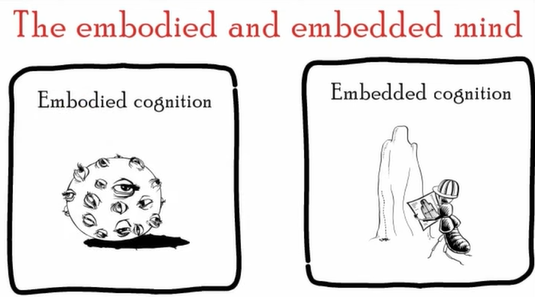
I found Winn’s (2003) overview of how cognitive neuroscience contributes to a system-theory view on learning a refreshing perspective on how learning occurs in artificial (digital) learning environments. This theory includes a conceptual framework that focuses on three interdependent aspects:
1. Cognition is embodied in physical activity
2. Cognition occurs in activity embedded in the learning environment, and
3. Learning results from reciprocal adaptation between the learner and the environment.
Winn presents updated information that supports a more sophisticated understanding of the cognitive neuroscience processes and behaviors in the context of complex systems interacting, thus providing a compelling theory as an alternative to constructivism. In the system theory, learning is a process of adaptation resulting from embodied (physically active) and embedded (immersed in an environment) cognition in a dynamic exchange between the learner and their environment.

Stevens’ (2012) article celebrates a return of the body as a central component in concepts and cognition, particularly in the space of mathematics, where, since the days of Plato, mathematics has been heralded as “have[ing] nothing material in them and are distinct from physical things”(Kline, 1972, p. 43, as cited in Stevens, 2012, p. 339).
Stevens acknowledges the nuanced differences between ‘conceptual’ embodiment and ‘interactionist’ embodiment in the literature, the first focusing more on the creation of complex ideas resulting from the cumulative lived reality of humans, and the second focusing more on the body as a physical form to create and manifest meaning and action. Despite the differences and the competing perspectives, Stevens articulates that, once again, the body is a force that must be acknowledged and reckoned with when addressing matters of teaching and learning, including the previously disembodied domain of mathematics.

My third article was by McCulloch et al. (2013) and their research on student use of graphing calculators. They examined the degree to which students trusted a graphing calculator solution, particularly when it differed from their hand-produced solution. They viewed their research through the instrumental genesis theory, which claims that learning is shaped by the tools used and their relationship with the tools. Their premise states that “the mathematical context matters, as the tool and the mathematical knowledge shape each other in the process of the instrumental genesis” (p. 202). Their data revealed four main patterns of behavior that were evident as students rationalized their interactions with their calculator:
1. The consideration of careless errors,
2. The routine of checking their manual work,
3. The recognition that the graphing calculator has various affordances/limitations, and
4. The degree of self-confidence in their math skills.
Their results showed some interesting findings, including that most students viewed their graphing calculator as the math master and would give it primary authority. Also, they found the graphing calculator contributed to the learning process by self-regulating their practice, as differences in answers would trigger a response in checking their work. In addition, the calculator could provide alternate means to represent solutions (graphs, tables, etc.), thus adding to their understanding. The articles presented above all focus on the role of embodied and material practices in mathematics learning and how these practices can support or hinder mathematical understanding. Together, these articles profile the significance of embodied methods for supporting mathematical knowledge and reasoning; thus, these practices should not be overlooked or undervalued in mathematics education
The articles presented above all focus on the role of embodied and material practices in mathematics learning and how these practices can support or hinder mathematical understanding. Together, these articles profile the significance of embodied methods for supporting mathematical knowledge and reasoning; thus, these practices should not be overlooked or undervalued in mathematics education.
Questions for reflection:
- In light of the theory of instrumental genesis, what practices might you apply to the use of technology such as the graphing calculator to ensure learners are developing critical thinking around its use?
- In what ways do you incorporate embodied and material practices in your math teaching practice to support student learning?
- How do you see these practices contributing to student understanding of mathematical concepts and reasoning?
References
McCulloch, A. W., Kenney, R. H., & Keene, K. A. (2013). What to trust: Reconciling mathematical work done by hand with conflicting graphing calculator solutions. School Science and Mathematics, 113(4), 201-210.
Stevens, R. (2012). The missing bodies of mathematical thinking and learning have been found. Journal of the Learning Sciences, 21(2), 337-346.
Winn, W. (2002). Learning in artificial environments: Embodiment, embeddedness and dynamic adaptation. Technology, Instruction, Cognition and Learning, 1(1), 87-114.
